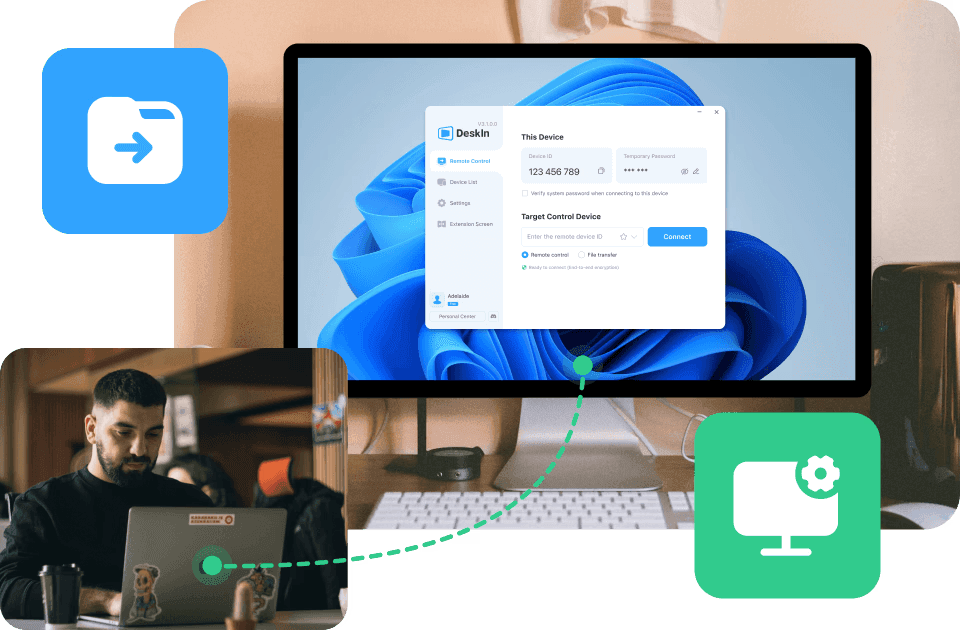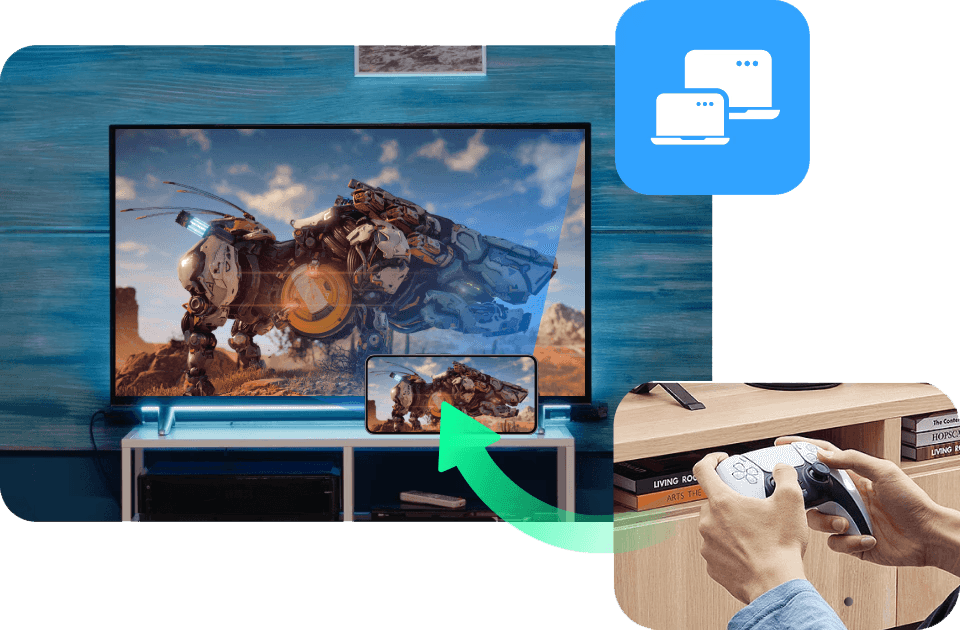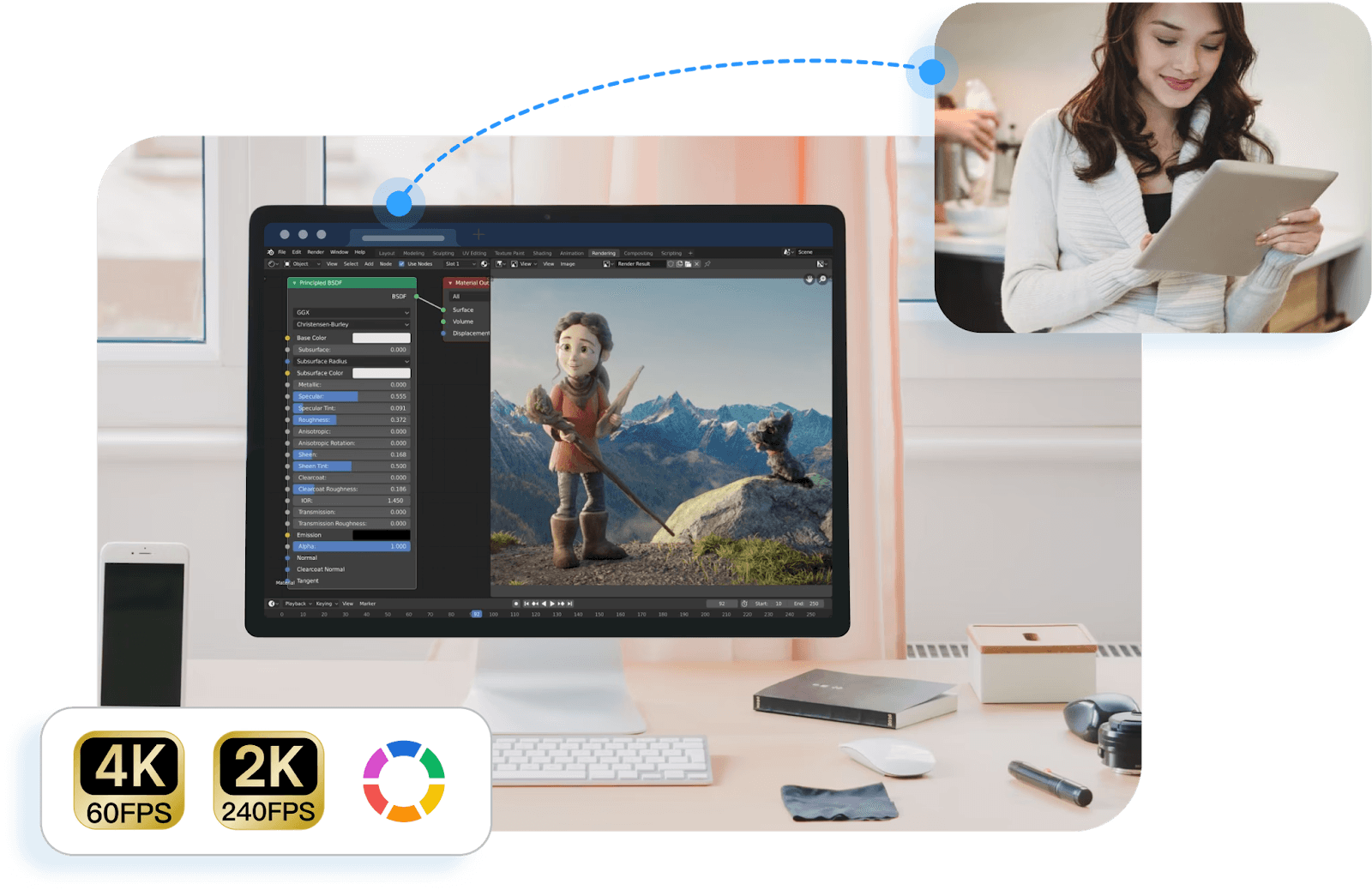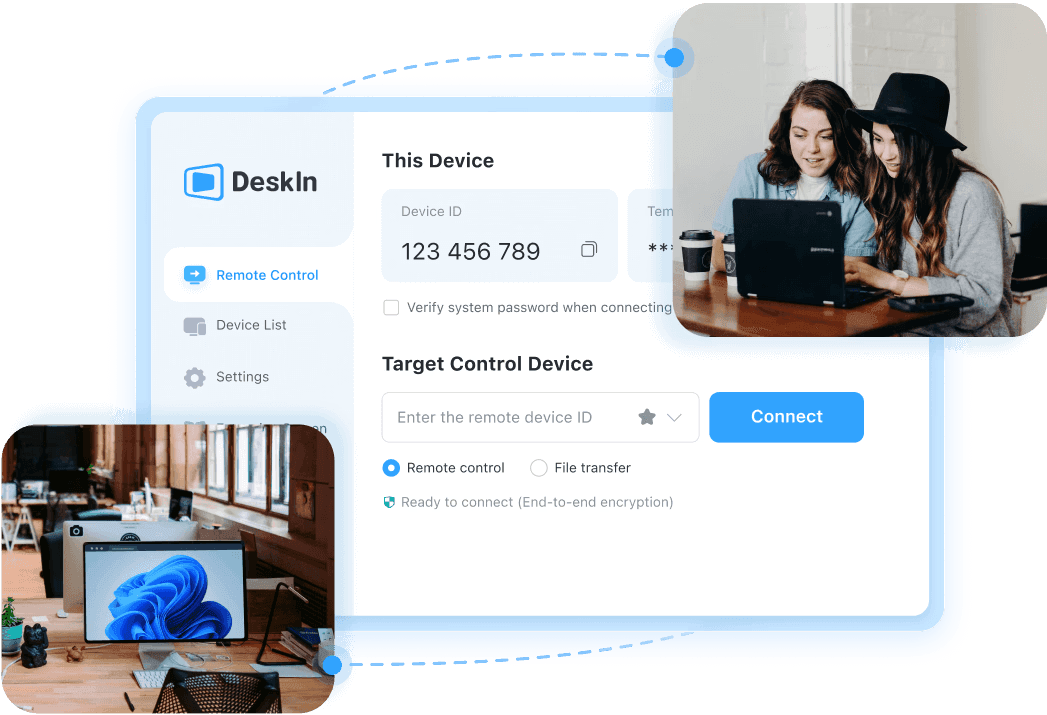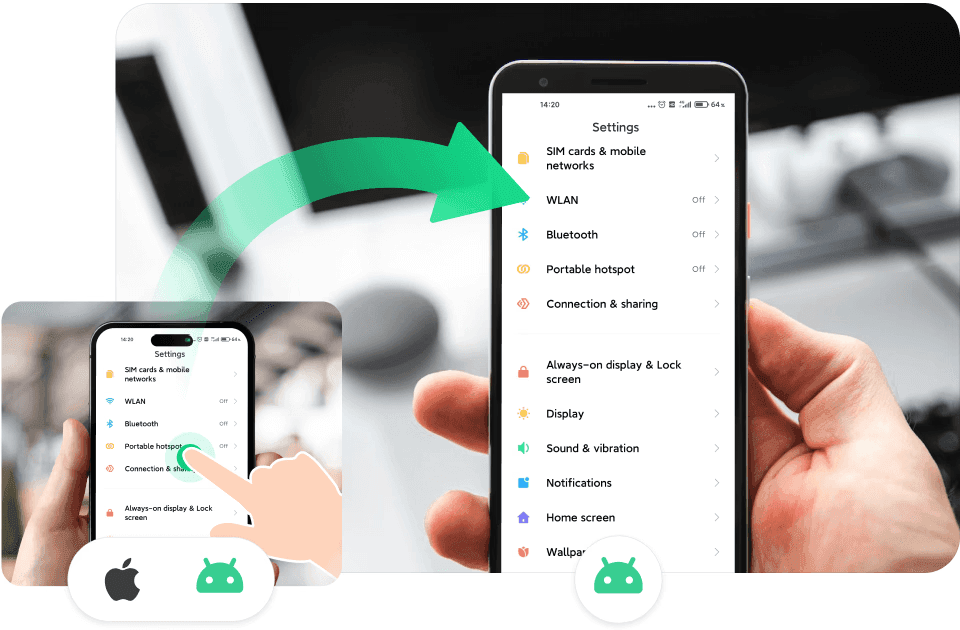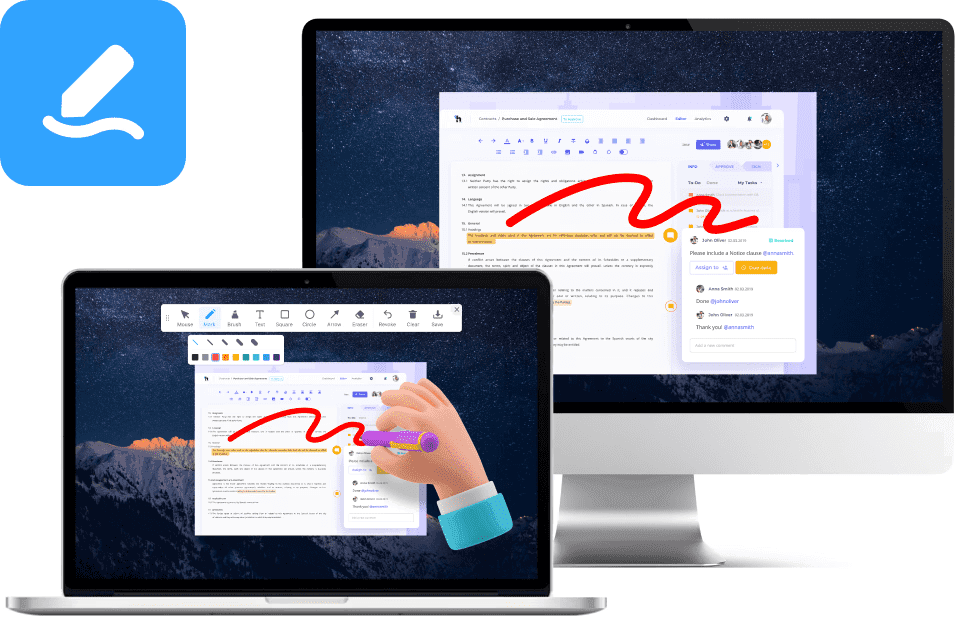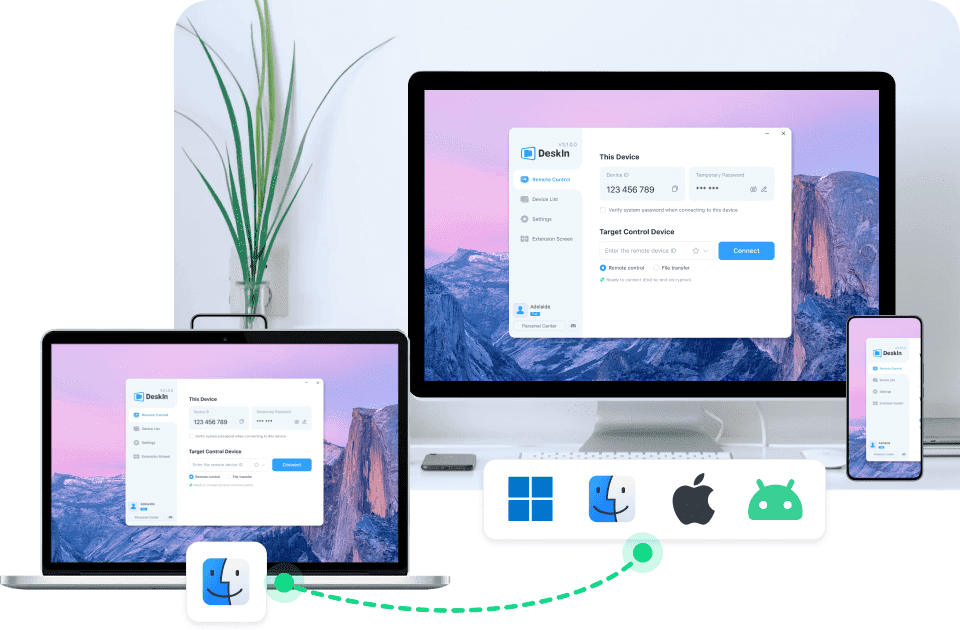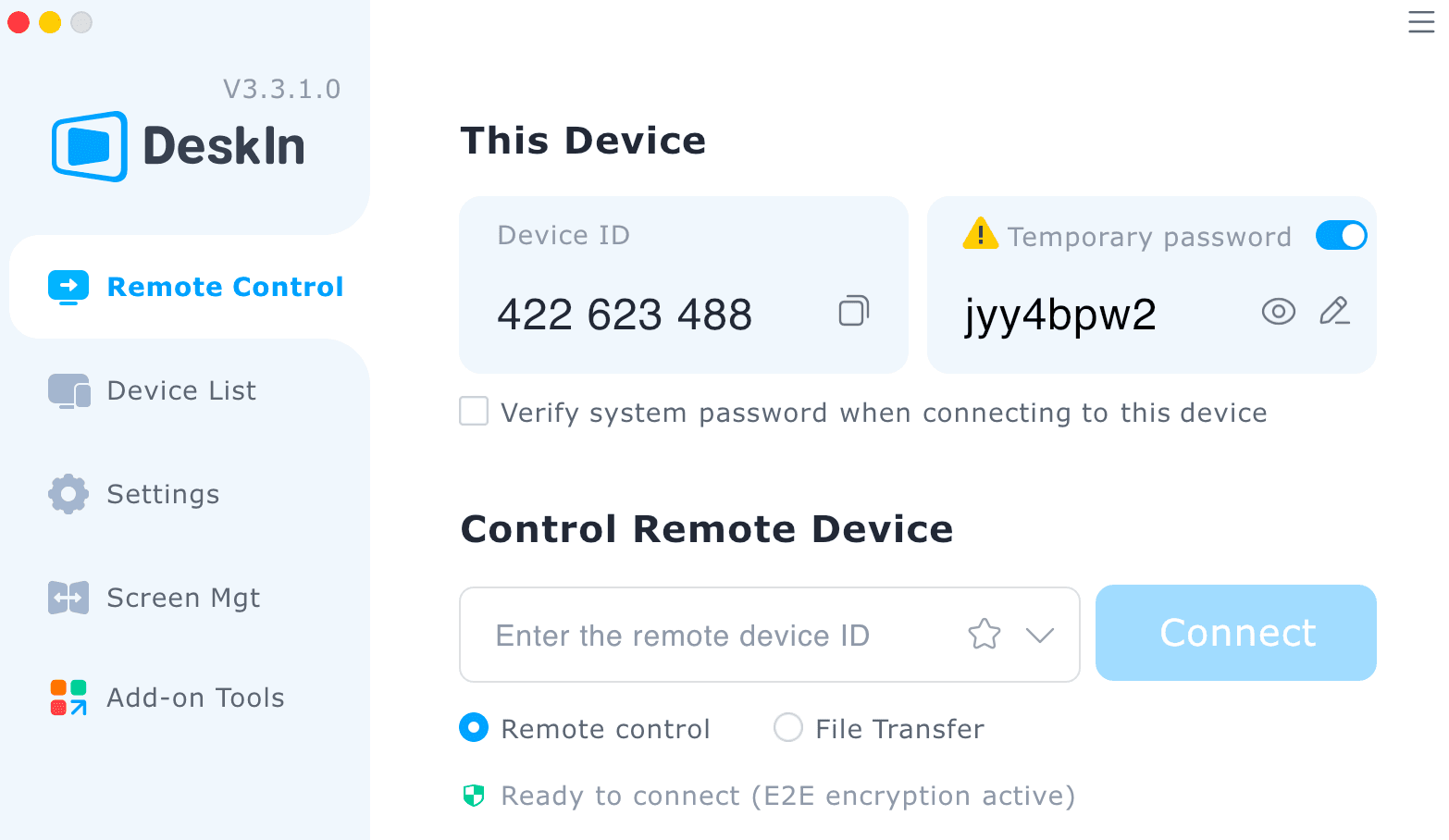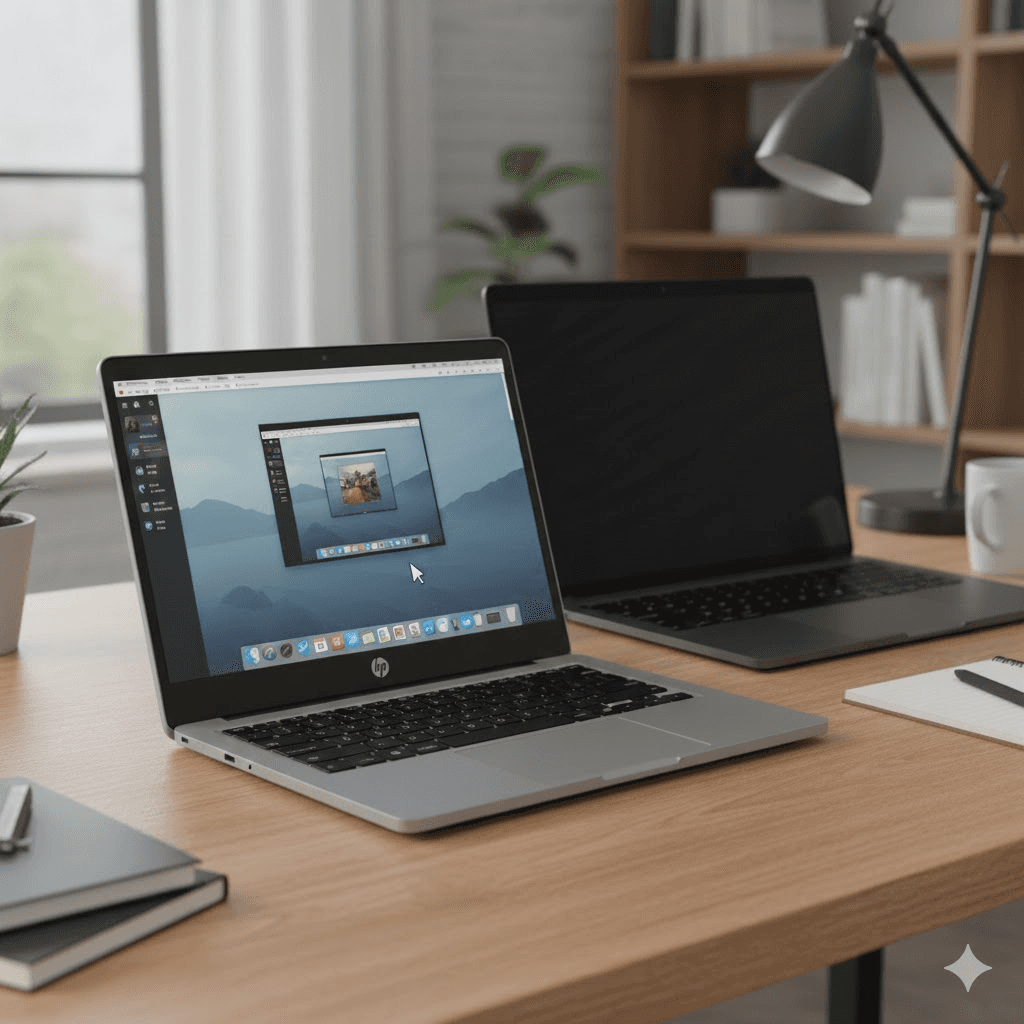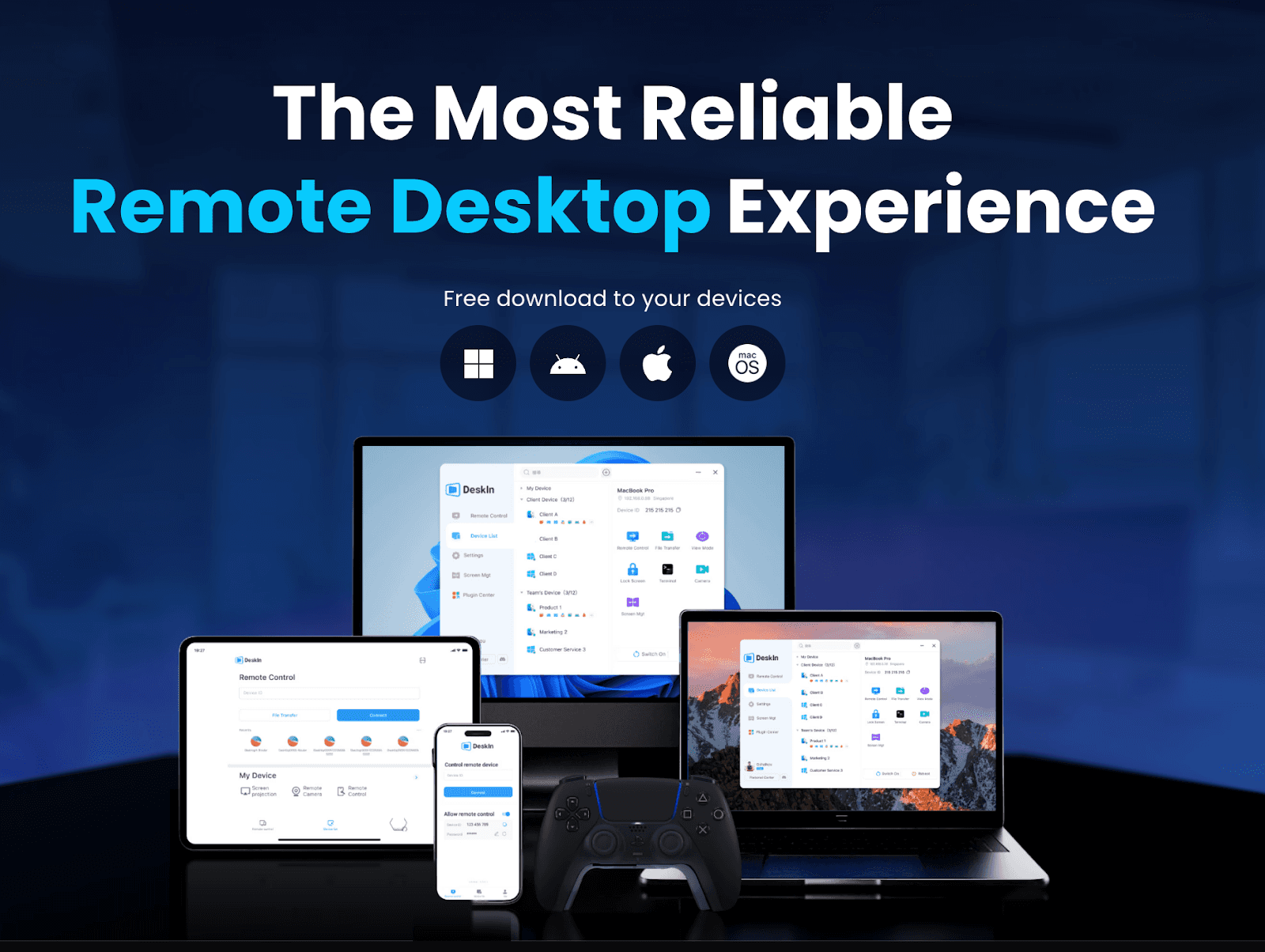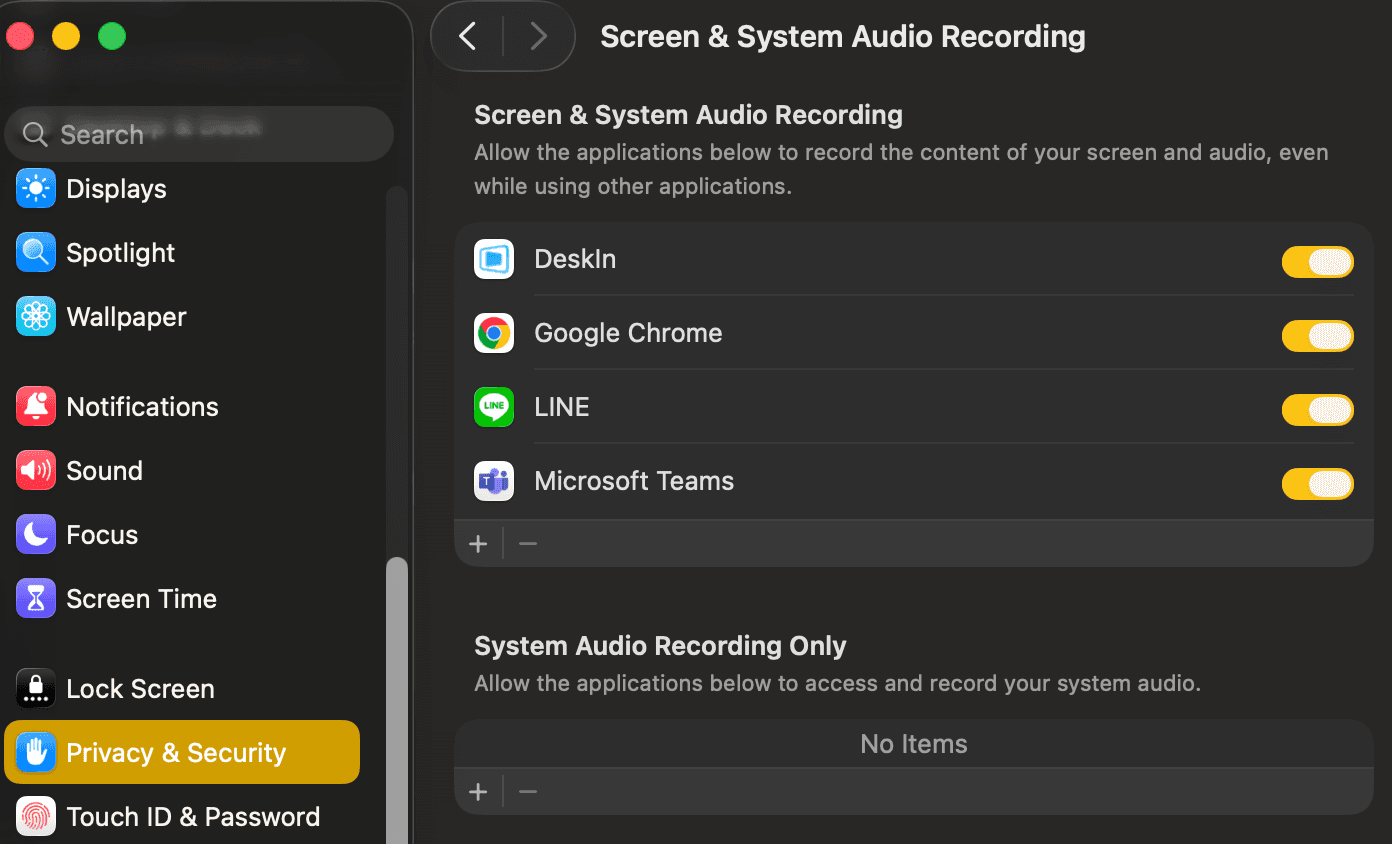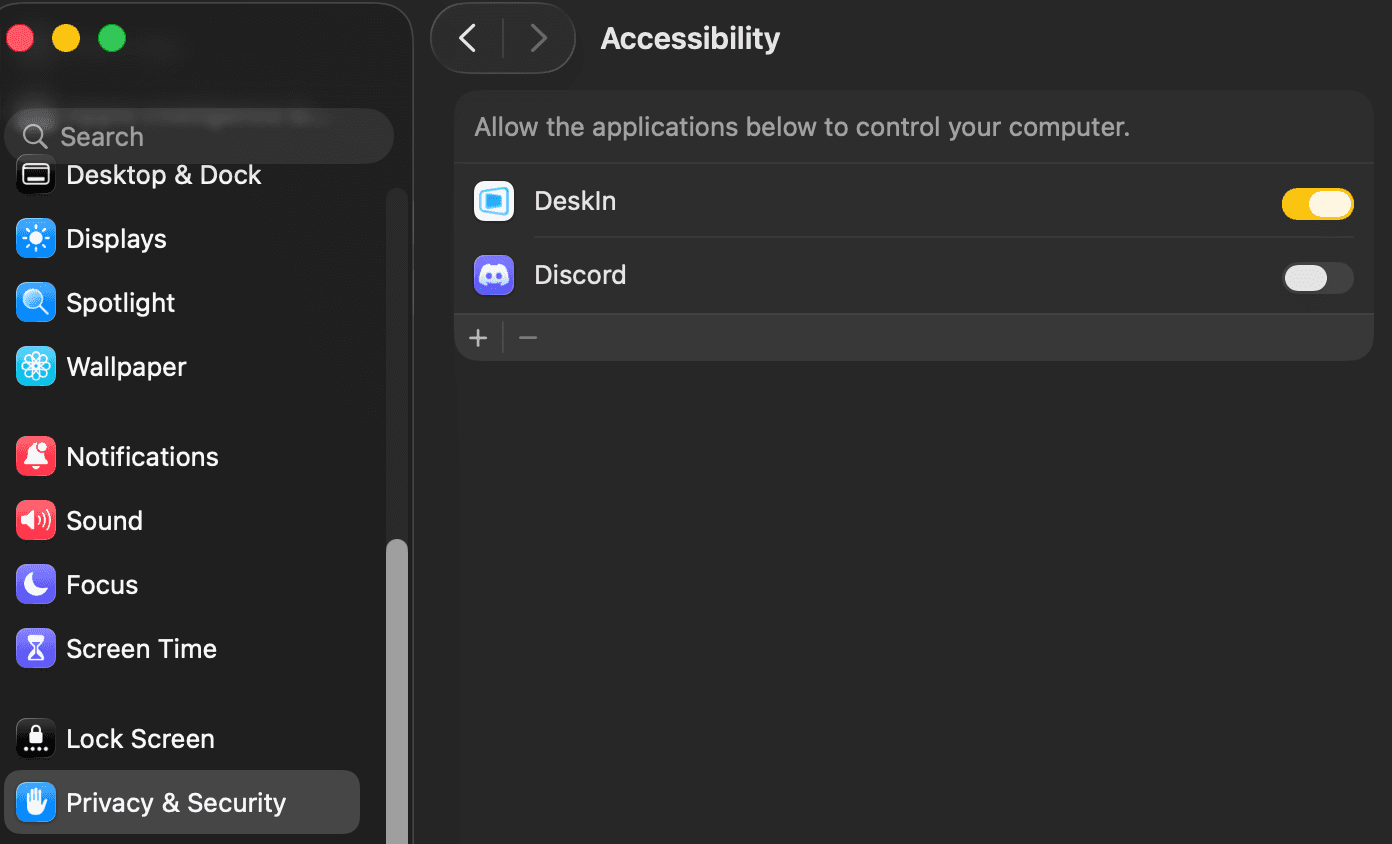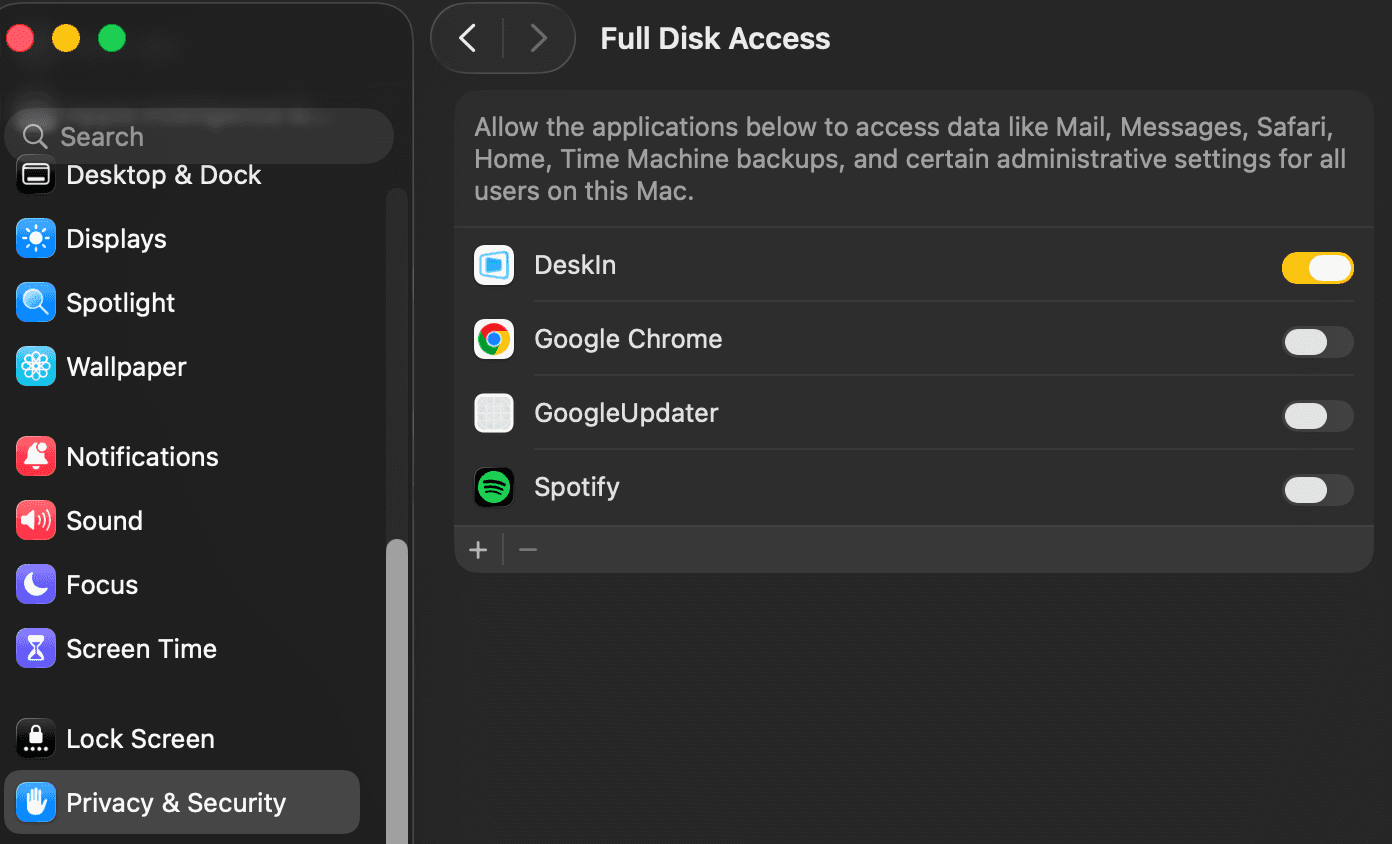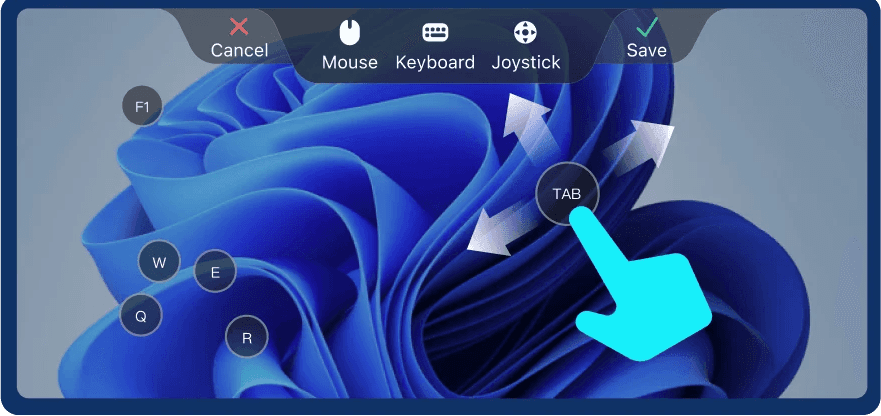In today's mobile-first world, connecting two Android phones remotely can unlock new levels of convenience, productivity, and support. Whether you're trying to help a friend fix an issue, send files without a computer, or mirror screens for presentations, remote connectivity between Android phones is incredibly useful.
With the right tools and know-how, common situations like long-distance tech support, collaborative work, or even gaming on another device are possible. Let's explore the tested ways to achieve remote access from Android to Android, starting with the most reliable solution.
Best Way to Connect Two Android Phones Remotely: Using DeskIn
If you're searching for the most efficient and secure way to connect two Android phones remotely, DeskIn stands out as the top choice. Designed for both casual users and professionals, DeskIn's Android app delivers real-time control, file sharing, and screen mirroring on Android phones, all with a simple setup and smooth user experience.
What makes DeskIn unique is its combination of high performance, cross-platform compatibility, and enterprise-level security, all wrapped into an easy-to-use interface. Whether you're using Samsung or another Android device, DeskIn offers a flexible, reliable solution for remote access Android to Android.
👍 Why Choose DeskIn for Remote Connection:
Stable Connection: Backed by over 200 global nodes to ensure low latency and consistent performance, even on weak wireless networks.
Feature-Rich Functionality: Control another Android phone, transfer files up to 12MB/s, screen mirror, annotate, make voice calls, and more.
Cross-Platform Support: Available on Android, iOS, Windows, and macOS for seamless integration across all your devices.
Enhanced Security: Includes email verification, privacy screen, black/whitelist controls, and unattended access settings.
Cost-Effective Plans: Offers a generous free version and competitive pricing compared to other major remote control solutions.
Now, let's walk through how to remotely connect two of your Android devices using the DeskIn app.
Step 1. Visit the official DeskIn website or search for it on Google Play, and install the app on both Android devices.

Step 2. Sign up with your email address and verify your account. Log in on both devices to establish secure access.
📌 Note: When logging in to your account for the first time on a new device, you need to complete email verification to ensure account security.
Step 3. After logging in, confirm the Device ID of the Android phone you want to control. On the controller device, enter that Device ID and the corresponding password. Make sure the target device has "Allow remote control" enabled in the DeskIn settings.

Step 4. Once the connection is established, you can remotely operate the other Android phone. You'll be able to launch apps, send messages, transfer files, etc.
Hurry up and try out DeskIn's great features!

👀 You May Also Like:
Other Ways for Two Android Devices to Connect
While DeskIn offers a full-featured and secure solution for remote access Android to Android, there are also built-in methods that can help you establish a connection between two Android devices, especially for tasks like file sharing or quick pairing. Below are 2 commonly used wireless methods.
Using Bluetooth for Wireless File Transfer
Bluetooth is one of the oldest and simplest methods to connect two Android phones wirelessly, ideal for short-range file transfers and basic device pairing. While it's not suited for full remote control, it's still useful for sharing media, contacts, or small files between devices.
If you need to connect and transfer large files over a long distance, we recommend using DeskIn. Just click the download button here to experience DeskIn's 12MB/s transfer speed!

Here is how to connect two Android devices remotely via bluetooth:
Open "Settings" on both Android phones and enable Bluetooth.
On one phone, tap "Pair new device", and select the other phone from the list of available devices.
Confirm the pairing request on both devices.
Once connected, you can select files, tap "Share", and choose Bluetooth as the sharing method.
Accept the incoming file on the receiving device.

Using Wi-Fi Direct
Wi-Fi Direct (or WLAN Direct) allows two Android devices to connect wirelessly at higher speeds than Bluetooth, without the need for an internet connection or external router. It's a good alternative when you want to transfer large files between phones. Here are the detailed steps for it.
However, please note that the two devices must be on the same network. If you need to control from a distance, we recommend using the remote control software DeskIn.
Go to "Settings > Connections > Wi-Fi" on both Android devices.
Tap the "Wi-Fi Direct option" (often found via the three-dot menu or advanced settings).
Your phone will start scanning. Select the other device once it appears.
Accept the connection request on the second device.
Use a compatible app (like Gallery or File Manager) to share files over Wi-Fi Direct.

Practical Scenarios for Remotely Connecting Android Devices
Beyond technical setup, it's important to understand real-world use cases for remote access Android to Android. Whether for personal convenience, professional collaboration, or helping others, these scenarios show why knowing how to connect two Android phones remotely is increasingly valuable.
Remote Assistance and Troubleshooting
One of the most common reasons to remotely connect two Android devices is to offer technical support. If a friend or family member struggles with settings, apps, or network issues, you can directly take control of their Android device to troubleshoot, without lengthy phone instructions. This is especially helpful for assisting elderly or less tech-savvy users, allowing you to tap, swipe, and navigate remotely, making fixes faster and easier.
For Parental Monitoring
Parents can remotely monitor a child's Android device to ensure safe browsing, manage screen time, or check app usage. Remote access provides greater oversight without needing to physically handle the child's phone.
For Remote Camera Access
Some remote control apps, like DeskIn, allow access to the device's camera, turning an Android phone into a portable security camera. This is useful for checking on pets, home security, or monitoring environments remotely.
File Sharing and Collaboration
Need to send large files or work together across devices? Remote connection between Android phones lets you transfer documents, photos, and videos directly, without relying on cloud services. DeskIn can transfer unlimited types, numbers, and sizes of files at 12MB/s. It's perfect for students sharing coursework, colleagues collaborating on projects, or creatives exchanging assets in real time, all with fast transfer speeds and no file type restrictions.
Screen Mirroring for Presentations and Media Sharing
Screen mirroring lets you display one Android device's screen on another, ideal for mobile presentations, media sharing, or demonstrating app functionality. It works even across different networks, making it a handy tool for meetings, travel, or casual entertainment. DeskIn stands out among screen mirroring apps for its low latency and cost-effectiveness.

FAQs About Remote Access Android to Android
Can I remotely connect two Android phones wirelessly?
Yes. Most modern remote access solutions support wireless connections over Wi-Fi or mobile data. You can also use remote connection software like DeskIn. This means the two devices don't need to be on the same local network, allowing you to remotely connect two Android phones even when they're miles apart.
Can I control call settings or answer calls remotely?
Some advanced tools provide partial control over call-related features. While you might not be able to answer regular phone calls directly through remote access, certain apps allow you to:
View and manage incoming call notifications
Adjust ringtones or audio settings
Use voice communication during the session for real-time assistance. (DeskIn has a call feature!)
Is remote access safe and private?
Security depends on the app you choose. Trusted remote access apps use strong encryption, secure logins (like email verification or two-factor authentication), and privacy settings such as screen masking or blacklist/whitelist controls. Always select reliable tools to ensure your data stays protected during remote sessions.
Does it work on Samsung phones?
Absolutely. Most remote access apps are fully compatible with Samsung and other popular Android brands. Some apps even include Samsung-specific optimizations for better performance or deeper system integration.
Conclusion
The ability to connect two Android phones remotely opens up a wide range of possibilities—from seamless tech support and file transfers to screen sharing and mobile presentations. Whether you're offering remote assistance to a friend, collaborating on a project, or simply looking for a smarter way to manage multiple devices, remote access Android to Android offers convenience, control, and flexibility.
Among the many tools available, DeskIn stands out for its powerful feature set, cross-platform compatibility, and secure remote sessions. With functions like full device control, fast file transfer, and screen mirroring over mobile data, DeskIn makes it easier than ever to remotely connect two Android phones for both professional and personal use!

In today's mobile-first world, connecting two Android phones remotely can unlock new levels of convenience, productivity, and support. Whether you're trying to help a friend fix an issue, send files without a computer, or mirror screens for presentations, remote connectivity between Android phones is incredibly useful.
With the right tools and know-how, common situations like long-distance tech support, collaborative work, or even gaming on another device are possible. Let's explore the tested ways to achieve remote access from Android to Android, starting with the most reliable solution.
Best Way to Connect Two Android Phones Remotely: Using DeskIn
If you're searching for the most efficient and secure way to connect two Android phones remotely, DeskIn stands out as the top choice. Designed for both casual users and professionals, DeskIn's Android app delivers real-time control, file sharing, and screen mirroring on Android phones, all with a simple setup and smooth user experience.
What makes DeskIn unique is its combination of high performance, cross-platform compatibility, and enterprise-level security, all wrapped into an easy-to-use interface. Whether you're using Samsung or another Android device, DeskIn offers a flexible, reliable solution for remote access Android to Android.
👍 Why Choose DeskIn for Remote Connection:
Stable Connection: Backed by over 200 global nodes to ensure low latency and consistent performance, even on weak wireless networks.
Feature-Rich Functionality: Control another Android phone, transfer files up to 12MB/s, screen mirror, annotate, make voice calls, and more.
Cross-Platform Support: Available on Android, iOS, Windows, and macOS for seamless integration across all your devices.
Enhanced Security: Includes email verification, privacy screen, black/whitelist controls, and unattended access settings.
Cost-Effective Plans: Offers a generous free version and competitive pricing compared to other major remote control solutions.
Now, let's walk through how to remotely connect two of your Android devices using the DeskIn app.
Step 1. Visit the official DeskIn website or search for it on Google Play, and install the app on both Android devices.

Step 2. Sign up with your email address and verify your account. Log in on both devices to establish secure access.
📌 Note: When logging in to your account for the first time on a new device, you need to complete email verification to ensure account security.
Step 3. After logging in, confirm the Device ID of the Android phone you want to control. On the controller device, enter that Device ID and the corresponding password. Make sure the target device has "Allow remote control" enabled in the DeskIn settings.

Step 4. Once the connection is established, you can remotely operate the other Android phone. You'll be able to launch apps, send messages, transfer files, etc.
Hurry up and try out DeskIn's great features!

👀 You May Also Like:
Other Ways for Two Android Devices to Connect
While DeskIn offers a full-featured and secure solution for remote access Android to Android, there are also built-in methods that can help you establish a connection between two Android devices, especially for tasks like file sharing or quick pairing. Below are 2 commonly used wireless methods.
Using Bluetooth for Wireless File Transfer
Bluetooth is one of the oldest and simplest methods to connect two Android phones wirelessly, ideal for short-range file transfers and basic device pairing. While it's not suited for full remote control, it's still useful for sharing media, contacts, or small files between devices.
If you need to connect and transfer large files over a long distance, we recommend using DeskIn. Just click the download button here to experience DeskIn's 12MB/s transfer speed!

Here is how to connect two Android devices remotely via bluetooth:
Open "Settings" on both Android phones and enable Bluetooth.
On one phone, tap "Pair new device", and select the other phone from the list of available devices.
Confirm the pairing request on both devices.
Once connected, you can select files, tap "Share", and choose Bluetooth as the sharing method.
Accept the incoming file on the receiving device.

Using Wi-Fi Direct
Wi-Fi Direct (or WLAN Direct) allows two Android devices to connect wirelessly at higher speeds than Bluetooth, without the need for an internet connection or external router. It's a good alternative when you want to transfer large files between phones. Here are the detailed steps for it.
However, please note that the two devices must be on the same network. If you need to control from a distance, we recommend using the remote control software DeskIn.
Go to "Settings > Connections > Wi-Fi" on both Android devices.
Tap the "Wi-Fi Direct option" (often found via the three-dot menu or advanced settings).
Your phone will start scanning. Select the other device once it appears.
Accept the connection request on the second device.
Use a compatible app (like Gallery or File Manager) to share files over Wi-Fi Direct.

Practical Scenarios for Remotely Connecting Android Devices
Beyond technical setup, it's important to understand real-world use cases for remote access Android to Android. Whether for personal convenience, professional collaboration, or helping others, these scenarios show why knowing how to connect two Android phones remotely is increasingly valuable.
Remote Assistance and Troubleshooting
One of the most common reasons to remotely connect two Android devices is to offer technical support. If a friend or family member struggles with settings, apps, or network issues, you can directly take control of their Android device to troubleshoot, without lengthy phone instructions. This is especially helpful for assisting elderly or less tech-savvy users, allowing you to tap, swipe, and navigate remotely, making fixes faster and easier.
For Parental Monitoring
Parents can remotely monitor a child's Android device to ensure safe browsing, manage screen time, or check app usage. Remote access provides greater oversight without needing to physically handle the child's phone.
For Remote Camera Access
Some remote control apps, like DeskIn, allow access to the device's camera, turning an Android phone into a portable security camera. This is useful for checking on pets, home security, or monitoring environments remotely.
File Sharing and Collaboration
Need to send large files or work together across devices? Remote connection between Android phones lets you transfer documents, photos, and videos directly, without relying on cloud services. DeskIn can transfer unlimited types, numbers, and sizes of files at 12MB/s. It's perfect for students sharing coursework, colleagues collaborating on projects, or creatives exchanging assets in real time, all with fast transfer speeds and no file type restrictions.
Screen Mirroring for Presentations and Media Sharing
Screen mirroring lets you display one Android device's screen on another, ideal for mobile presentations, media sharing, or demonstrating app functionality. It works even across different networks, making it a handy tool for meetings, travel, or casual entertainment. DeskIn stands out among screen mirroring apps for its low latency and cost-effectiveness.

FAQs About Remote Access Android to Android
Can I remotely connect two Android phones wirelessly?
Yes. Most modern remote access solutions support wireless connections over Wi-Fi or mobile data. You can also use remote connection software like DeskIn. This means the two devices don't need to be on the same local network, allowing you to remotely connect two Android phones even when they're miles apart.
Can I control call settings or answer calls remotely?
Some advanced tools provide partial control over call-related features. While you might not be able to answer regular phone calls directly through remote access, certain apps allow you to:
View and manage incoming call notifications
Adjust ringtones or audio settings
Use voice communication during the session for real-time assistance. (DeskIn has a call feature!)
Is remote access safe and private?
Security depends on the app you choose. Trusted remote access apps use strong encryption, secure logins (like email verification or two-factor authentication), and privacy settings such as screen masking or blacklist/whitelist controls. Always select reliable tools to ensure your data stays protected during remote sessions.
Does it work on Samsung phones?
Absolutely. Most remote access apps are fully compatible with Samsung and other popular Android brands. Some apps even include Samsung-specific optimizations for better performance or deeper system integration.
Conclusion
The ability to connect two Android phones remotely opens up a wide range of possibilities—from seamless tech support and file transfers to screen sharing and mobile presentations. Whether you're offering remote assistance to a friend, collaborating on a project, or simply looking for a smarter way to manage multiple devices, remote access Android to Android offers convenience, control, and flexibility.
Among the many tools available, DeskIn stands out for its powerful feature set, cross-platform compatibility, and secure remote sessions. With functions like full device control, fast file transfer, and screen mirroring over mobile data, DeskIn makes it easier than ever to remotely connect two Android phones for both professional and personal use!


Play x Work
All at Once
DeskIn Remote Game
only $14.32 USD 🎉 Limited on July 16-31
Add promo code: deskinsummer1






